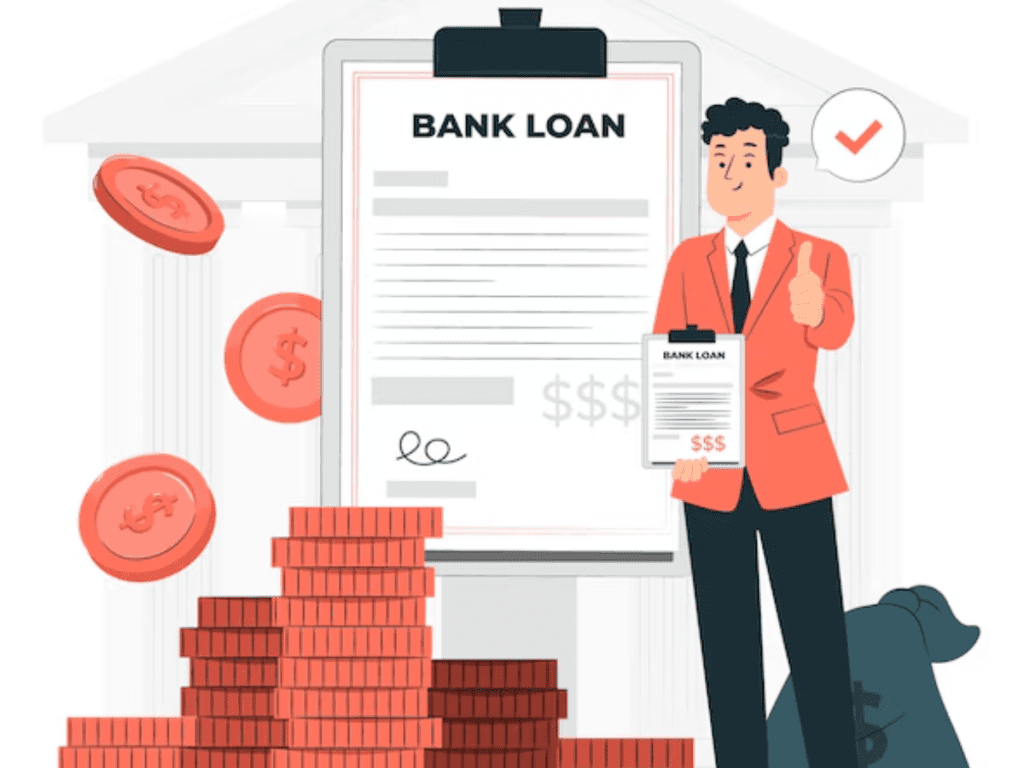Introduction
Inflation is a widespread phenomenon in the economy that touches almost all areas of personal finance. From the cost of goods and services to salaries and interest rates, inflation impacts the financial choices we make, particularly when borrowing money. For borrowers, it is important to know how inflation affects loan interest rates in order to manage debt and borrow wisely.
With rising inflation, the cost of borrowing increases. Inflation-driven interest rates on loans can either become a burden for borrowing or present opportunities for smart borrowing. Here, we’ll discuss the inflation-interest rate relationship in greater detail, see how inflation affects borrowers, and provide tips on how to borrow intelligently during periods of inflation.
Understanding Inflation and Its Effect on Loan Interest Rates
Inflation is the overall rise in the prices of goods and services in an economy over a certain period of time. It is generally quantified by indexes such as the Consumer Price Index (CPI) and the Producer Price Index (PPI). As inflation increases, money’s purchasing power is reduced, and the same money will purchase fewer goods or services. Both consumers and companies are affected by this phenomenon and contribute greatly to the general cost of living.
In terms of borrowing, inflation influences interest rates, which in turn impacts the cost of loans. To understand this better, it’s important to look at how inflation and interest rates are linked.
1. Central Bank’s Role in Inflation and Interest Rates
The central bank of a country—such as the Federal Reserve in the United States—plays a key role in managing inflation through monetary policy. When inflation rises above a target level, central banks may increase interest rates to slow down the economy and reduce inflationary pressures. Higher interest rates make borrowing more expensive and encourage saving rather than spending, which helps reduce demand and bring down inflation.
Conversely, when the economy is experiencing low inflation or recessionary pressures, central banks will decrease interest rates to encourage borrowing and investment, which can foster economic growth.
2. Lender Risk and Inflation
Inflation also directly impacts the amount of risk involved for lenders in making loans. When inflation is high, money lent by lenders today will not be as valuable when it is repaid sometime in the future. To cover this loss in purchasing power, lenders will often increase interest rates. This makes sure that they get a return on their investment that covers inflation as well as the risk of lending.
The lenders’ risk is augmented by future inflation uncertainty. With changing inflation pressures, lenders fix interest rates to protect themselves from expected losses, and borrowers tend to experience the impact of the change.
3. Fixed-Rate and Variable-Rate Loans in an Inflation Economy
Interest rates on loans can be fixed or variable. Both fixed-rate loans and variable-rate loans respond to inflation, but differently:
- Fixed-Rate Loans: Fixed-rate loans, i.e., fixed-rate mortgage or personal loans, carry an interest rate that is constant until the end of the loan. These loans are certain, as the borrower gets to know exactly what interest rate and monthly installment they will pay. In times of inflation, securing a fixed rate proves beneficial since it enables the borrower to take advantage of a low rate prior to inflation pushing interest rates upward.
- Variable-Rate Loans: Variable-rate loans, conversely, contain interest rates which may fluctuate over time as a function of market conditions. Variable-rate loans are most sensitive to inflation because interest rates have a tendency to increase when inflation rises. Thus, variable-rate loan borrowers’ monthly payments tend to increase when inflation causes interest rates to go up.
Given the fluctuating nature of variable rates, borrowers with this type of loan may find it challenging to predict their future payments and budget accordingly. However, for those with fixed-rate loans, they are often able to benefit from stable, lower rates while inflation is high.
How Inflation Affects Borrowers
The effect of inflation on loan interest rates has a direct bearing on borrowers. Increasing interest rates increase the cost of borrowing, and inflation adds to the cost further. The following is how inflation influences borrowers:
1. Increased Monthly Payments
The most direct consequence of inflation is the rise in interest rates, and this will contribute directly to an increase in monthly loan payments. When the central bank increases the interest rates to fight inflation, lending institutions also raise the interest rates on loans. This implies that the same level of borrowing will produce higher monthly payments, as the borrower will be paying a higher rate of interest.
With long-term loans like mortgages, inflation can have especially large effects. A small percentage increase in interest on a very large loan may mean thousands of dollars more to pay over the life of the loan.
2. Increased Total Loan Cost
Inflationary pressure not only increases the cost of borrowing each month, but it also adds to the total price of a loan. Whether you have a fixed or variable loan, the total paid out over the term of the loan will be greater if interest rates rise. This can seriously affect your ability to pay back the loan and overall financial well-being.
If you are thinking of borrowing, say to finance a home, car, or business, the same loan may cost you an awful lot of money in the form of interest payments because of inflation. Inflation pushes interest rates higher, and this might make it difficult for borrowers to achieve their own financial objectives or make big purchases.
3. Less Borrowing Power
As interest rates go up because of inflation, the effective amount you can borrow goes down. Banks generally consider your income, debt-to-income ratio, and interest rate while deciding how much they can lend you. With increasing interest rates, your debt-to-income ratio rises, and banks may cap the amount of the loan they are willing to lend.
This message is that in an inflationary climate, you might not be able to borrow as much money as you previously could. Whether you want to purchase a home, fund a car, or access a personal loan, inflation could lower your borrowing power and cut down your financial flexibility.
4. Potential for Default
Inflation may make it more difficult for borrowers to service loan repayments, particularly if their incomes are not rising at the same pace as inflation. As the cost of living increases as a result of inflation, borrowers can become stretched thin financially, resulting in the possibility of late payments, penalty charges, and even loan default.
Higher interest rates and rising living costs can create financial stress, particularly for those already dealing with other debts or struggling with stagnant wages. It’s crucial to plan ahead and ensure that your budget can accommodate higher loan payments before committing to any large borrowing.
How to Borrow Smartly in an Inflationary Environment
Inflation will complicate borrowing, but you have options available for handling increased interest rates and smartly borrowing money. Through intelligent strategies and precise planning, you can minimize inflation’s influence on your loan and make a wise financial decision.
1. Lock in a Fixed-Rate Loan
One of the greatest defenses against increasing interest rates in times of inflation is to secure a fixed-rate loan. When you are shopping for a mortgage, personal loan, or car loan, locking in a fixed-rate loan before rates rise can pay off big time in the long run. Your payments remain fixed, and you won’t have to cringe at inflation pushing your interest rate higher.
This technique is especially good for long-term loans, including home loans, because it allows you to maintain the same rate of interest for the entire duration of the loan period, regardless of whether interest rates rise in the future due to inflation.
2. Refinance Your Loans
If you already hold a variable interest rate loan, refinancing into a fixed interest rate loan might be a savvy decision when there is inflation. Refinancing allows you to secure a lower, fixed interest rate before they increase further. But consider balancing the cost of refinancing in terms of fees and closing fees to see whether the long-term savings are well worth the upfront cost.
Besides refinancing variable-rate loans, you may also want to consolidate multiple loans to simplify your payments and get a better interest rate. Consolidating debt can lower your interest rate overall, decrease monthly payments, and make it easier to pay off your debt.
3. Pay Off High-Interest Debt Quickly
When there’s inflation, it’s particularly critical to focus on paying off high-interest debt, like credit card debt or payday loans. High-interest debt is notorious for piling up rapidly and making it more difficult to become financially successful. By eliminating this kind of debt first, you can lower the amount of interest you’re paying and reduce your total borrowing expense.
Where feasible, use additional income, tax returns, or windfalls to service high-interest debt more intensively. This will not only decrease your monthly expenses but also save you from future increases in interest rates on your current debt.
4. Find Loans with Low Fixed-Interest Rates
Not everything borrowed is under the same interest rate, and it pays to shop around and get the best offer. In an inflationary environment, look for low fixed-interest loans as these will be more predictable and financially secure. Shop around among different lenders and look to use online resources to help identify the best loan deals on offer to you.
5. Revise Your Budget and Reduce Non-Essential Expenses
Inflation will boost your monthly bills, so it’s wise to revise your budget. If you have loans, pay them off first, and reduce discretionary spending to save more money for loan payments. For instance, cut back on eating out, entertainment expenses, or subscription plans, and allocate those savings to debt repayment.
By having and adhering to a stringent budget, you can be able to cope with increasing living expenses and have enough funds to support your loan payments despite inflation affecting your finances.

